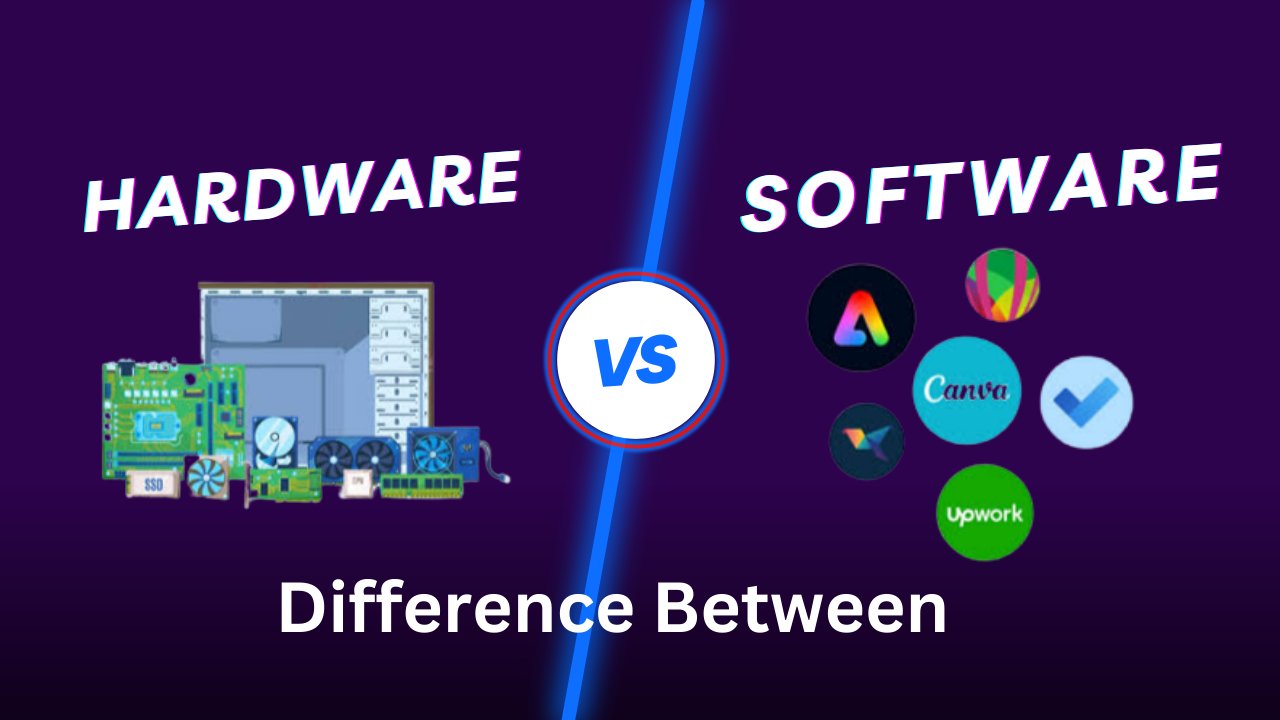Difference between Hardware and Software

Difference between Hardware and Software
In the realm of technology, two fundamental components govern the functioning of any computerized system: hardware and software. Understanding the distinction between these two terms is essential for comprehending how computers operate and how they can be utilized effectively. In this blog post, we will delve into the difference between hardware and software, exploring their differences and highlighting their respective roles in computing.
Defining Hardware and Software:
Hardware: Hardware refers to the physical components of a computer system that can be touched, seen, and interacted with. It encompasses tangible devices such as the central processing unit (CPU), memory modules, hard drives, keyboards, monitors, and other peripheral devices. These physical components work in unison to process, store, and transmit data within a computer system.
Software: Software, on the other hand, comprises the intangible programs, applications, and instructions that govern the functioning of a computer system. It consists of lines of code, algorithms, and data that enable computers to perform specific tasks and operations. Software can be categorized into system software (e.g., operating systems) and application software (e.g., word processors, web browsers, and multimedia players).

Understanding the Differences:
- Physical vs. Virtual Existence: The primary distinction between hardware and software lies in their physicality. Hardware is tangible and can be physically manipulated, replaced, or upgraded. Software, however, exists in a virtual form as a collection of instructions and data stored on hardware components, such as hard drives or solid-state drives.
- Functionality: Hardware provides the foundation for a computer system to operate. It performs tasks such as data processing, storage, and input/output operations. Software, on the other hand, utilizes the hardware’s capabilities to perform specific tasks, enabling users to interact with the system, run applications, and accomplish various computational activities.
- Modifiability: Hardware components are typically fixed and unalterable once manufactured. Upgrading or modifying hardware often requires physically replacing components. Software, however, offers a higher level of flexibility and can be easily modified, updated, or replaced without necessarily changing the underlying hardware.
- Lifespan and Obsolescence: Hardware components tend to have a longer lifespan, although they may eventually become obsolete due to advancements in technology. Software, on the other hand, can be regularly updated and improved, allowing it to evolve and adapt to changing requirements and technologies.
- Cost Considerations: Hardware components generally involve higher upfront costs due to the manufacturing, assembly, and physical resources required. Software, while often requiring initial investment, can have a lower overall cost as updates and modifications can be implemented without incurring significant manufacturing expenses.
- Interdependence: Hardware and software are interdependent components, relying on each other for proper functioning. Hardware provides the physical infrastructure and resources necessary for software to execute instructions and process data. Conversely, software utilizes the capabilities of hardware to perform tasks and achieve specific outcomes.
Difference between Hardware and Software;
Here are some important differences between the Hardware and Software;
| Hardware |
Software |
| Hardware is a physical component of computers that executes the instruction. | Software is a program that enables users to interact with the computer, its hardware. |
| It is manufactured in factories. | It is developed by software programmers or software development companies. |
| Storage Devices, Input Devices, Output Devices, and Internal components are the primary categories of hardware. | Operating Systems, Application Software, and Programming Software are the main categories of software. |
| Hardware can be seen and touch as it is a physical, electronic device. | The software can be seen but cannot be touched as it is virtual, not physical. |
| Computer viruses cannot affect hardware. | Computer viruses can affect software. |
| Hardware can be replaced with a new one if it is damaged. | The software is reinstalled if it gets damaged. |
| Through the network, hardware cannot be transferred electrically. Only, it can be physically transferred. | The software can be transferred easily. |
| Examples of hardware are RAM, ROM, Printer, Monitor, Mouse, Hard disk and more. | Examples of software are Google Chrome, MySQL, MS Word, Excel, PowerPoint, Notepad, Photoshop and more. |
Conclusion:
In the world of computing, hardware and software are inseparable entities, each playing a crucial role in the functioning of computer systems. Hardware encompasses the physical components, while software consists of programs and instructions that enable computers to perform tasks. Understanding the distinction between hardware and software is vital for users to make informed decisions when acquiring, maintaining, and utilizing computer systems. By appreciating the characteristics and differences of these two fundamental elements, individuals can leverage technology to its fullest potential and harness the power of these for their personal and professional needs.
Learn More;



0 Comments